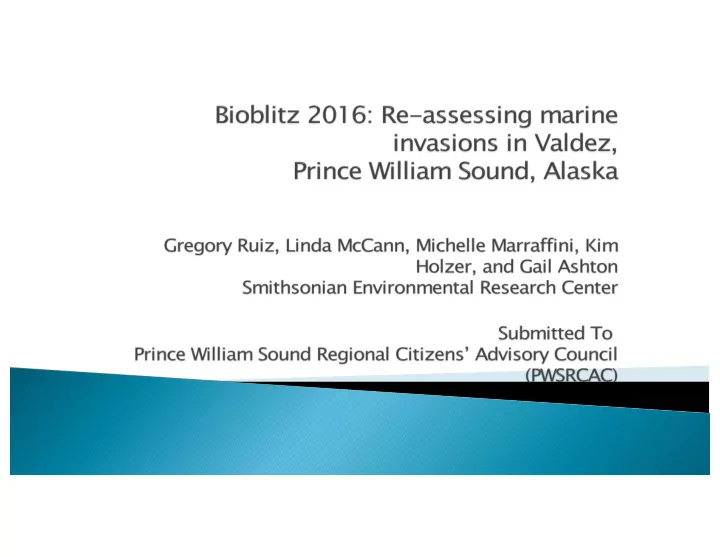

To help advance citizen science and genetic methods to detect NIS in Prince William Sound (1) Bioblitz and training event for detection of target NIS (2) Zooplankton training for RCAC staff (3) Surveys of fouling communities in Valdez and PWS
} An intensive short term (1-2 day) survey effort to collect and identify species } This effort used several different sampling techniques: •diver collection •plankton tows •fouling surveys •crab traps
Ra Rapid As Asses essme Fo Fouling nt nt Plankto Pl Community Co Crab Cr ab Di Dive Lo Loca catio ion Surve Su vey n Tow n ows Pl Plates Tr Traps Su Surve veys Va Valdez Marina 1 3 5 6 Va Valdez Ferry Te Terminal 3 1 Al Alyes yeska Ter erminal 3 20 Va Valdez Container Do Dock 1 1 Ta Tati titl tlek Co Cordo dova a Mar arina 9 TO TOTA TALS 1 9 34 6 3
} assess marine biodiversity and detect introduced species } plates suspended underwater from docks and serve as passive collectors for colonization by marine invertebrates
} Results: ◦ No new NIS were detected in any of our surveys ◦ Species composition of the fouling community similar to previous studies ◦ only cryptogenic species the bryozoan, Fenestrulina delicia , found in previous fouling surveys
engage the public in marine invasion science } provide training to citizen scientists } presentations } experiential learning in: basic taxonomy, target species, field work protocols, and data recording
} Results: ◦ Provided a broad overview of invasion science and specific training for identification and detection methods for target NIS relevant to PWS ◦ training to help RCAC implement a zooplankton sampling program, which aims to detect target NIS in PWS using genetic tools
} Monitoring and sampling training } Rapid survey of fouling communities of Valdez Marina } Surveys included settlement plates crab traps rapid assessment of dock structures
} Results: ◦ The bioblitz rapid surveys in the marina yielded no NIS
} The European green crab introduced to the west coast of California in the 1990’s } steadily moving northward along the coast } most recently detected <100 miles from the Alaskan border } Six traps, 3 minnow (juveniles) and 3 collapsible (adults) deployed in the subtidal at the Valdez Marina
} Results : ◦ Crab trapping yielded native crab species only, in both minnow and collapsible traps
} dive surveys examined man-made maritime infrastructure in high transit areas and } Expanded the survey area assessed with settlement plates } Dive locations included: •Valdez Ferry dock •Valdez Container •Terminal pilings •Tatitlek Ferry dock
} Results: ◦ Only one NIS the non-native bryozoan Schizoporella japonica
The bioblitz and training activities served multiple purposes } Rapid surveys to detect target NIS } overview and training on NIS detection for a diverse audience } initiate a zooplankton sampling program } fouling community plate surveys in Valdez
} Successful volunteer programs require training and also benefit from focus on particular (few) target taxa } We recommend a sustained NIS detection program in PWS that includes both citizen scientists and genetic zooplankton sampling over time, ideally with annual measures. } In addition, we also recommend that community-level comprehensive surveys be implemented at 2-5 year intervals
Recommend
More recommend